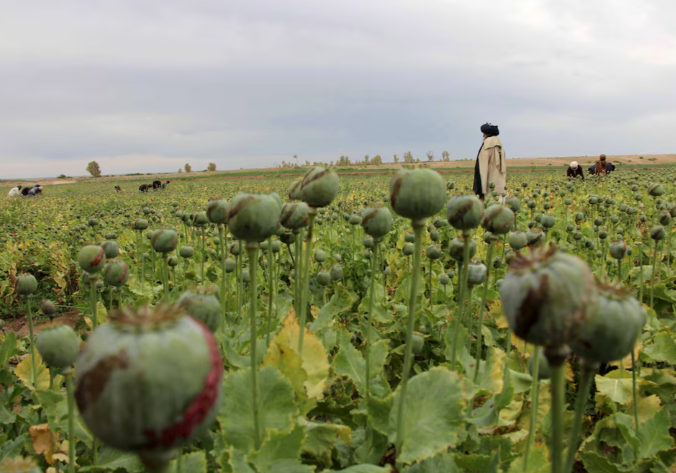Concerns Regarding Opium Stockpiles in Afghanistan (GS Paper 3, IR)

Why in News?
- The latest report by the United Nations Security Council (UNSC) has highlighted significant concerns regarding Afghanistan's extensive opium stockpiles.
- This comes despite the Taliban's ban on poppy cultivation, emphasizing the persistent challenges in curbing narcotics production and trafficking in the region.
Key Findings of the Report
- Substantial Opium Stockpiles: Despite the Taliban's ban in April 2022, Afghanistan continues to have large stockpiles of opium. These stockpiles suggest that the full impact of the ban will not be immediately visible and could take several years to assess.
- Continued Narcotics Trade: The trade in narcotics remains robust, with seizure data indicating no significant reduction in drug exports. This points to the ongoing prevalence of drug trafficking networks.
- Taliban Involvement: Senior Taliban figures and well-connected traders, including the Haqqani Network, are still profiting from drug trafficking. Key Taliban members control various narcotics trafficking routes.
- Increase in Methamphetamine Production: There has been a surge in methamphetamine production, with significant quantities of fentanyl also being recorded. Major hubs for methamphetamine production include Farah, Herat, and Nimroz provinces, with active labs in Bahramcha, Dishu district, and Helmand province.
Implications of Opium Stockpiles and Drug Trafficking
- Trafficking Networks: A significant portion of drugs trafficked to India originates from Afghanistan, with Pakistan's Inter-Services Intelligence (ISI) agency playing a key role in controlling these networks. This has serious implications for regional security and drug control efforts.
- Terrorism Funding: Drug money is increasingly being used to fund anti-India terror groups such as Lashkar-e-Taiba (LeT). Narcotics procured from Afghanistan are labeled in clandestine laboratories in Balochistan and then smuggled into India.
- Significant Seizures: Indian security agencies have uncovered direct links between Kandahar-based cartels and drug smuggling networks. Notable seizures include the National Investigation Agency (NIA) intercepting 3,000 kg of heroin at Mundra port in September 2021.
- Government Response: The Union Home Minister has urged security agencies to adopt a ruthless approach towards smuggling networks. The central government is working on installing container scanners at all ports and land border crossings to curb drug trafficking.
Initiatives to Tackle Drug Abuse
Global Initiatives:
- Single Convention on Narcotic Drugs, 1961: This treaty aims to limit the possession, use, trade, distribution, import, export, manufacture, and production of drugs exclusively to medical and scientific purposes.
- Convention on Psychotropic Substances, 1971: It establishes an international control system for psychotropic substances.
- UN Convention against Illicit Traffic in Narcotic Drugs and Psychotropic Substances, 1988: It addresses the global issue of drug trafficking.
- United Nations Office on Drugs and Crime (UNODC): Established in 1997, UNODC combines the United Nations International Drug Control Program (UNDCP) and the Crime Prevention and Criminal Justice Division of the United Nations Office in Vienna. It focuses on drug control and crime prevention.
Indian Initiatives:
- Nasha Mukt Bharat Abhiyaan/Drugs-Free India Campaign: Aimed at creating awareness and promoting a drug-free society.
- National Action Plan for Drug Demand Reduction: Focuses on preventive education, awareness generation, and capacity building.
- Narco-Coordination Centre: Ensures effective coordination among various agencies dealing with drug-related issues.
- National Fund to Control Drug Abuse: Provides financial support for activities related to drug abuse control.
Famous Hotspots of Illicit Drugs
- Golden Triangle: A region in Southeast Asia known for the production of illicit drugs, particularly Opium, where the borders of Myanmar, Laos, and Thailand meet.
- Golden Crescent or “Death Crescent”: Includes Afghanistan and Iran, making it a natural transit point for drugs being smuggled out of Pakistan.
Opium Regulation and Uses
Regulation:
- The Narcotics Commissioner under the Narcotic Drugs & Psychotropic Substances Act 1985 oversees the cultivation of the opium poppy and production of opium.
- Currently, opium poppy cultivation is confined to notified tracts in Madhya Pradesh, Rajasthan, and Uttar Pradesh. Mandsaur district of Madhya Pradesh and Chittorgarh and Jhalawar Districts of Rajasthan constitute about 80% of the total area cultivated.
Uses of Opium:
- Opium has unique therapeutic value and is indispensable in the medical world.
- It is used in Homeopathy, Ayurveda, and Unani systems of indigenous medicines.
- Opium is used as an analgesic, antitussive, antispasmodic, and as a source of edible seed oil.
Conclusion
- The UNSC report underscores the persistent challenges posed by Afghanistan's opium stockpiles and the extensive narcotics trade.
- Despite the Taliban's ban, significant stockpiles and ongoing drug trafficking highlight the complex nature of the issue.
- This has serious implications for regional security, particularly for India, where drug trafficking networks linked to Afghanistan continue to thrive.
- India's efforts to combat these issues involve both international collaboration and stringent domestic measures to curb the illegal drug trade and reduce drug abuse.
- The development and implementation of global and national initiatives are crucial in addressing the multifaceted challenges of narcotics production and trafficking.


